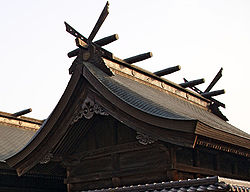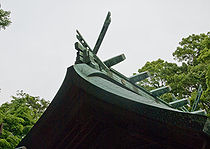
Chigi (architecture)
Encyclopedia

Japanese architecture
' originated in prehistoric times with simple pit-houses and stores that were adapted to a hunter-gatherer population. Influence from Han Dynasty China via Korea saw the introduction of more complex grain stores and ceremonial burial chambers....
and Shinto Architecture
Shinto architecture
Shinto architecture is the architecture of Japanese Shinto shrines.With a few exceptions, the general blueprint of a Shinto shrine is Buddhist in origin. Before Buddhism, shrines were just temporary structures erected to a particular purpose. Buddhism brought to Japan the idea of permanent shrines...
. Chigi predate Buddhist
Buddhism
Buddhism is a religion and philosophy encompassing a variety of traditions, beliefs and practices, largely based on teachings attributed to Siddhartha Gautama, commonly known as the Buddha . The Buddha lived and taught in the northeastern Indian subcontinent some time between the 6th and 4th...
influence and are an architectural element endemic to Japan
Japan
Japan is an island nation in East Asia. Located in the Pacific Ocean, it lies to the east of the Sea of Japan, China, North Korea, South Korea and Russia, stretching from the Sea of Okhotsk in the north to the East China Sea and Taiwan in the south...
. They are an important aesthetic aspect of Shinto shrines, where they are often paired with katsuogi
Katsuogi
or are short, decorative logs found on Japanese and Shinto architecture. They are placed at a right angle along the ridge of roofs, and are usually featured in religious or imperial architecture. Katsuogi predate Buddhist influence and is an architectural element endemic to Japan. They are...
, another type of roof ornamentation. Today, chigi and katsuogi are used exclusively on Shinto buildings and distinguish them from other religious structures, such as Buddhist temples in Japan
Buddhist temples in Japan
Along with Shinto shrines, Buddhist temples are the most numerous, famous, and important religious buildings in Japan.The term "Shinto shrine" is used in opposition to "Buddhist temple" to mirror in English the distinction made in Japanese between Shinto and Buddhist religious structures. In...
.
Origin
Chigi is thought to have been employed on Japanese buildings starting from the 1st century AD. Their existence during the Jōmon period (250–538) is well documented by numerous artifacts. Measurements for chigi were mentioned in an early document, the Taishinpō Enryaku Gishikichō (太神宝延暦儀式帳), written in 804 AD.
Bargeboard
Bargeboard is a board fastened to the projecting gables of a roof to give them strength and to mask, hide and protect the otherwise exposed end of the horizontal timbers or purlins of the roof to which they were attached...
planks that were left uncut. Another is that they were part of a support system anchored on the ground to stabilize the roof
Roof
A roof is the covering on the uppermost part of a building. A roof protects the building and its contents from the effects of weather. Structures that require roofs range from a letter box to a cathedral or stadium, dwellings being the most numerous....
. Yet another theory proposes that they were used to "pinch" and hold thatch roofing together. Evidence of this can be seen in minka
Minka
are private residences constructed in any one of several traditional Japanese building styles.In the context of the four divisions of society, minka were the dwellings of farmers, artisans, and merchants , but this connotation no longer exists in the modern Japanese language, and any traditional...
, or common traditional homes, where two interlocking timbers are often found at the roof gable
Gable
A gable is the generally triangular portion of a wall between the edges of a sloping roof. The shape of the gable and how it is detailed depends on the structural system being used and aesthetic concerns. Thus the type of roof enclosing the volume dictates the shape of the gable...
s. However, the only certain fact is that chigi were originally a working part of the structure, but as building techniques improved, their function was lost and they were left as decorations.
Chigi were likely only to have decorated the homes and warehouses of powerful families, and more decorations signified higher rank. This traditional continued until relatively recent times. In the 17th to 19th centuries, the legal code
Legal code
A legal code is a body of law written by a governmental body, such as a U.S. state, a Canadian Province or German Bundesland or a municipality...
dictated how many chigi were allowed on a building roofs in accordance with the owner's social rank. Today, chigi are found only on Shinto
Shinto
or Shintoism, also kami-no-michi, is the indigenous spirituality of Japan and the Japanese people. It is a set of practices, to be carried out diligently, to establish a connection between present day Japan and its ancient past. Shinto practices were first recorded and codified in the written...
shrines.
Design
Chigi may be built directly into the roof as part of the structure, or simply attached and crossed over the gable as an ornament. The former method is believed to closer resemble its original design, and is still utilized in older building methods such as shinmei-zukuriShinmei-zukuri
is an ancient Japanese architectural style typical of Ise Grand Shrine's honden, the holiest of Shinto shrines. It is most common in Mie prefecture.-History:...
, kasuga-zukuri
Kasuga-zukuri
is a traditional Shinto shrine architectural style which takes its name from Kasuga Taisha's honden. It is characterized by the use of a building just 1x1 ken in size with the entrance on the gabled end covered by a veranda. In Kasuga Taisha's case, the honden is just 1.9 m x 2.6 m.Supporting...
, and taisha-zukuri
Taisha-zukuri
is the oldest Shinto shrine style. Named after Izumo Taisha's honden , like Ise Grand Shrine's shinmei-zukuri style it features a bark roof decorated with poles called chigi and katsuogi, plus archaic features like gable-end pillars and a single central pillar...
.

More ornate chigi, such as at Ise Shrine
Ise Shrine
is a Shinto shrine dedicated to goddess Amaterasu-ōmikami, located in the city of Ise in Mie prefecture, Japan. Officially known simply as , Ise Jingū is in fact a shrine complex composed of a large number of Shinto shrines centered on two main shrines, and ....
, are cut with one or two kaza-ana, or "wind-slots", and a third open cut at the tip, giving it a forked appearance. Gold metal coverings serve both protective and ornamental purposes. Usually, if the tops are cut vertically, the enshrined kami is a male, otherwise a female.
The katsuogi
Katsuogi
or are short, decorative logs found on Japanese and Shinto architecture. They are placed at a right angle along the ridge of roofs, and are usually featured in religious or imperial architecture. Katsuogi predate Buddhist influence and is an architectural element endemic to Japan. They are...
, a short decorative log, is often found behind the chigi. Depending on the building, there may be only one katsuogi accompanying the chigi, or an entire row along the ridge of the roof.
Names
Names for chigi can vary from region. In KyotoKyoto
is a city in the central part of the island of Honshū, Japan. It has a population close to 1.5 million. Formerly the imperial capital of Japan, it is now the capital of Kyoto Prefecture, as well as a major part of the Osaka-Kobe-Kyoto metropolitan area.-History:...
, Nara Prefecture
Nara Prefecture
is a prefecture in the Kansai region on Honshū Island, Japan. The capital is the city of Nara.-History:The present-day Nara Prefecture was created in 1887, making it independent of Osaka Prefecture....
, and Hiroshima
Hiroshima
is the capital of Hiroshima Prefecture, and the largest city in the Chūgoku region of western Honshu, the largest island of Japan. It became best known as the first city in history to be destroyed by a nuclear weapon when the United States Army Air Forces dropped an atomic bomb on it at 8:15 A.M...
, they are called uma (馬). In parts of Toyama
Toyama Prefecture
is a prefecture of Japan located in the Hokuriku region on Honshū island. The capital is the city of Toyama.Toyama is the leading industrial prefecture on the Japan Sea coast, and has the industrial advantage of cheap electricity due to abundant water resources....
, Osaka
Osaka
is a city in the Kansai region of Japan's main island of Honshu, a designated city under the Local Autonomy Law, the capital city of Osaka Prefecture and also the biggest part of Keihanshin area, which is represented by three major cities of Japan, Kyoto, Osaka and Kobe...
, Kōchi
Kochi Prefecture
is a prefecture of Japan located on the south coast of Shikoku. The capital is the city of Kōchi.- History :Prior to the Meiji Restoration, Kōchi was known as Tosa Province and was controlled by the Chosokabe clan in the Sengoku period and the Yamauchi family during the Edo period.- Geography...
, Tokushima and Miyazaki
Miyazaki Prefecture
is a prefecture of Japan located on the island of Kyushu. The capital is the city of Miyazaki.- History :Historically, after the Meiji Restoration, Hyūga Province was renamed Miyazaki Prefecture....
prefectures, they are called umanori (馬乗); in some areas of Yamagata
Yamagata Prefecture
-Fruit:Yamagata Prefecture is the largest producer of cherries and pears in Japan. A large quantity of other kinds of fruits such as grapes, apples, peaches, melons, persimmons and watermelons are also produced.- Demographics :...
, Miyagi
Miyagi Prefecture
is a prefecture of Japan in the Tōhoku Region on Honshu island. The capital is Sendai.- History :Miyagi Prefecture was formerly part of the province of Mutsu. Mutsu Province, on northern Honshu, was one of the last provinces to be formed as land was taken from the indigenous Emishi, and became the...
, Yamanishi
Yamanashi Prefecture
is a prefecture of Japan located in the Chūbu region of the island of Honshū. The capital is the city of Kōfu.-Pre-history to the 14th century:People have been living in the Yamanashi area for about 30,000 years...
, Hiroshima
Hiroshima
is the capital of Hiroshima Prefecture, and the largest city in the Chūgoku region of western Honshu, the largest island of Japan. It became best known as the first city in history to be destroyed by a nuclear weapon when the United States Army Air Forces dropped an atomic bomb on it at 8:15 A.M...
and Kōchi
Kochi Prefecture
is a prefecture of Japan located on the south coast of Shikoku. The capital is the city of Kōchi.- History :Prior to the Meiji Restoration, Kōchi was known as Tosa Province and was controlled by the Chosokabe clan in the Sengoku period and the Yamauchi family during the Edo period.- Geography...
prefectures, they are called kurakake (鞍掛).
See also
- KatsuogiKatsuogior are short, decorative logs found on Japanese and Shinto architecture. They are placed at a right angle along the ridge of roofs, and are usually featured in religious or imperial architecture. Katsuogi predate Buddhist influence and is an architectural element endemic to Japan. They are...
- Shinto architectureShinto architectureShinto architecture is the architecture of Japanese Shinto shrines.With a few exceptions, the general blueprint of a Shinto shrine is Buddhist in origin. Before Buddhism, shrines were just temporary structures erected to a particular purpose. Buddhism brought to Japan the idea of permanent shrines...
- Shinto shrine
- The Glossary of ShintoGlossary of ShintoThis is the glossary of Shinto, including major terms the casual reader might find useful in understanding articles on the subject. Words followed by an asterisk are illustrated by an image in one of the photo galleries...
for terms concerning Shinto and Shinto architecture.

